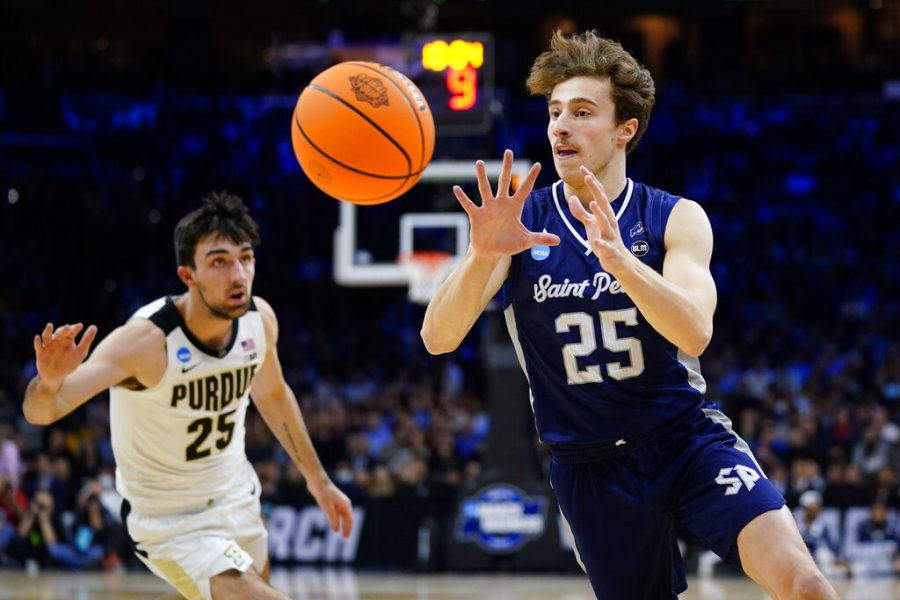Opinion: Transfer portal creating drastic changes in college hoops
FILE -Saint Peter’s Doug Edert, right, reaches for a pass past Purdue’s Ethan Morton during the first half of a college basketball game in the Sweet 16 round of the NCAA tournament, Friday, March 25, 2022, in Philadelphia. Kansas, Villanova, North Carolina and Duke will play in the first Final Four to take place under the new world of “name, image and likeness” endorsements in college sports. It allows college players to earn money through endorsements. And as his team’s Cinderella run to the Elite Eight gained steam, Saint Peter’s guard Doug Edert got into the act, announcing on Instagram that he’d struck a deal to hawk chicken wings.(AP Photo/Matt Rourke, File)
The transfer portal: could it be the catalyst that causes the downfall of college basketball? Rising collegiate stars would argue that it has aided them in their careers, but in using it, they have practically abandoned their teams in favor of seizing a spot on a team of a higher ranking than their previous one.
The NCAA transfer portal was created in October of 2018 to manage and facilitate the transfer process for student athletes. The portal is primarily for the use of players, and it has recently been heavily utilized to their advantage. Entering your name in the portal does not guarantee departure from your team, as you are allowed to withdraw your name at any time. Additionally, schools are not required to keep a player on scholarship once they enter the portal.
College football players have made notable transfers in the news, but not nearly as notable as college basketball players. The rates of basketball transfers are much higher when compared with football transfers. These switches can be key for individual players but devastating to teams as a whole.
Many pros and cons can be applied to this argument, and players and coaches have different opinions on the subject. While it may truly assist a rising talent to join a team that more closely meets his standards, it certainly does not help out coaches or teams.
Originally, if you were an athlete on scholarship, you had to tell your coach that you wanted a transfer, and he would have to approve your release. However, those rules have changed. Players are not required to tell anyone that they have entered the portal – not even their coaches. So, if he chose to do so, a player could leave his team and his coaches completely uninformed about his search for a new school.
Even when players announce publicly their intentions to enter the portal, it is still problematic when players who have flourished and developed as a direct result of a school’s athletic program want to leave it.
After Saint Peter’s historic run in March Madness this year, 22-year-old guard Doug Edert announced that he has entered the transfer portal. Joe Tipton of On3 reported the news on Edert, who had this to say: “I want to start by thanking my family, friends, coaches, teammates and Peacock Nation for an amazing three years at Saint Peter’s University. I have nothing but love for everyone who has been by my side throughout my journey. With that being said, I have entered the transfer portal. I’m excited for what is to come and looking forward to exploring other opportunities for my basketball career.”
But where does this leave Saint Peter’s? And should that even matter?
The whole conversation raises this question: is it right for players to put their own personal goals above the importance of loyalty to their coaches and their teams? Both sides should be taken into consideration. If a player’s team is almost completely unknown and barely visible, wanting to have better opportunities elsewhere is justifiable. However, if the high-profile team a player is already a part of just has one poor season, maybe he should stick it out with that team.
Additionally, the recent retirements of well-known coaches like Jay Wright of Villanova, Roy Williams of North Carolina, and Mike Krzyzewski of Duke, have made some wonder if the transfer portal was a factor in their decisions to leave. If the possibility exists that players the coaches spend time recruiting, teaching, and coaching can transfer without a single word, it makes it increasingly difficult for them to build and maintain teams and to ensure that their top recruits are truly committed to their programs.
The 2022-23 Division I men’s basketball season is set to start on November 8, 2022, so, until then, the transfer portal’s use will most likely see an increase in the number of transfers.


